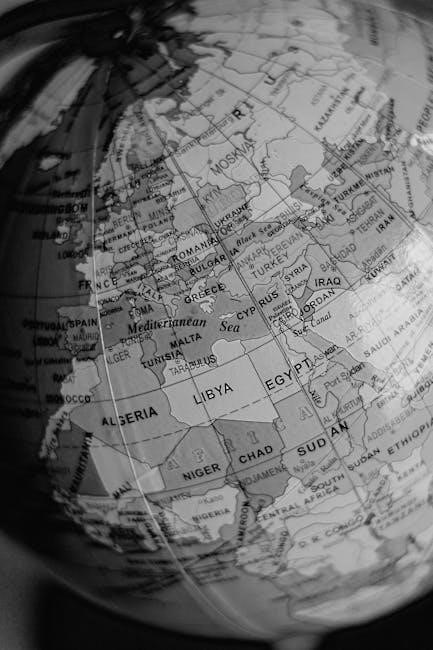This textbook provides a comprehensive exploration of modern world history, designed for 10th-grade students․ It covers key themes such as globalization, cultural changes, and historical developments․ The PDF version offers an interactive learning experience, aligning with educational standards and supporting both students and educators with engaging resources․
Overview of the Curriculum
The 10th-grade world history curriculum is structured to provide students with a deep understanding of global events and their interconnectedness․ It begins with an exploration of the Renaissance and its cultural impact, followed by the Age of Exploration and its consequences․ The curriculum then delves into significant political revolutions, including the American and French Revolutions, and their influence on modern governance․ The Industrial Revolution is also a key focus, examining its economic and social transformations․ Additionally, the curriculum covers both World Wars, the Cold War, and the process of decolonization․ Themes of globalization, nationalism, and contemporary challenges are integrated throughout the course․ The textbook is designed to align with educational standards, offering a balanced mix of historical narratives, primary sources, and interactive digital resources for enhanced learning․ This comprehensive approach ensures students develop critical thinking and historical analysis skills․
Importance of Studying World History
Studying world history is essential for understanding the complexities of human societies and the interconnectedness of global cultures․ It fosters critical thinking, cultural awareness, and empathy by examining past events and their impact on modern societies․ By exploring diverse civilizations, students gain insights into the development of ideas, religions, and political systems that shape today’s world․ World history also helps students recognize patterns and cycles, enabling them to better navigate contemporary challenges․ The curriculum encourages learners to analyze primary sources and historical narratives, developing skills in research and problem-solving․ Additionally, it promotes global citizenship by highlighting the shared experiences and unique perspectives of different regions․ This foundational knowledge prepares students to engage thoughtfully with the complexities of an increasingly interconnected world, making it a vital component of a well-rounded education․
Structure of the Textbook
The 10th-grade world history textbook is organized chronologically and thematically to provide a comprehensive understanding of global developments․ It begins with an introduction to the study of history, followed by chapters on the Renaissance, exploration, revolutions, and industrialization․ The textbook includes sections on modern history, such as World War I, World War II, the Cold War, and decolonization․ Each chapter features primary sources, maps, and timelines to enhance learning․ The PDF version is divided into sections, making it easy to navigate․ Additional resources, like study guides and interactive features, are integrated to support student engagement․ The structure ensures a balanced mix of depth and breadth, preparing students for advanced historical analysis while maintaining clarity and accessibility․

The Renaissance and Its Impact
The Renaissance, beginning in Europe, marked a cultural and intellectual revival․ It inspired advancements in art, science, and philosophy, shaping modern society and historical perspectives globally․
The Renaissance in Europe
The Renaissance in Europe, spanning the 14th to 17th centuries, was a cultural and intellectual revival․ It originated in Italy, spreading across the continent and transforming art, science, and philosophy․ This era saw iconic figures like Leonardo da Vinci and Michelangelo, whose works epitomized humanism and innovation․ The Renaissance challenged medieval traditions, fostering a renewed interest in classical knowledge and individualism․ Urban centers like Florence and Venice became hubs of creativity and trade, driving economic growth․ The invention of the printing press by Gutenberg revolutionized education, making knowledge more accessible․ This period laid the groundwork for the Enlightenment and modern scientific thought․ The Renaissance not only reshaped European society but also left a lasting legacy in global culture and intellectual history․
The Protestant Reformation
The Protestant Reformation was a pivotal movement in the 16th century that challenged the authority of the Roman Catholic Church․ Initiated by figures like Martin Luther and John Calvin, it sought to reform religious practices and doctrine․ Luther’s Ninety-Five Theses criticized indulgences and sparked widespread debate․ The Reformation led to the emergence of Protestant denominations, altering the religious landscape of Europe․ It also influenced political structures, as rulers began to support Protestantism to gain independence from the Church․ The Reformation emphasized individual faith, promoting literacy through vernacular Bibles․ This movement had profound social and cultural impacts, reshaping education and governance․ Its legacy continues to influence modern religious and societal dynamics, making it a cornerstone of world history studies in the 10th-grade curriculum․

Exploration and Colonization
European exploration and colonization reshaped global trade, culture, and politics․ Explorers sought new routes, resources, and territories, driven by economic and religious motivations․ This period established colonies, influencing indigenous populations and shaping modern nation-states․
The Age of Exploration
The Age of Exploration, spanning the 15th to 17th centuries, was a period of global discovery and transformation․ Driven by economic motives, technological advancements, and a desire for new trade routes, European nations like Portugal and Spain led the way․ Explorers such as Christopher Columbus and Ferdinand Magellan embarked on voyages that connected Europe, the Americas, Africa, and Asia․ These journeys introduced new cultures, resources, and ideas, reshaping global dynamics․ The Columbian Exchange, for instance, transferred crops, diseases, and populations between the Old and New Worlds․ While exploration brought wealth and knowledge, it also led to colonization, exploitation, and the displacement of indigenous peoples․ This era laid the foundation for modern globalization and the interconnectedness of our world today․
Impact of Colonization on Indigenous Populations
Colonization had devastating effects on indigenous populations worldwide․ The arrival of European colonizers brought diseases like smallpox, to which native populations had no immunity, leading to significant population decline․ Indigenous peoples were forcibly displaced from their lands, and their cultures were often suppressed or erased․ Many were subjected to violence, enslavement, and exploitation, disrupting their social and economic systems․ The loss of traditional ways of life and the imposition of foreign systems caused long-term trauma and marginalization․ Despite these hardships, indigenous communities showed remarkable resilience, resisting colonization and preserving their identities․ Understanding this history is crucial for acknowledging the injustices of the past and working toward reconciliation and justice in the modern world․

Political Revolutions
Political revolutions reshaped societies, driven by Enlightenment ideas and demands for liberty․ They challenged monarchies, leading to the rise of democratic ideals and modern nation-states globally․
The American Revolution
The American Revolution (1775–1783) was a pivotal event in world history, marking the colonies’ struggle for independence from British rule․ It began due to growing tensions over taxation without representation and restrictions on colonial expansion․ The Declaration of Independence in 1776 formally declared the colonies’ freedom, establishing the United States and promoting democratic ideals․ The Revolution was influenced by Enlightenment thinkers, emphasizing liberty and self-governance․ Key events included the Battles of Lexington and Concord, the Valley Forge encampment, and the decisive victory at Yorktown with French support․ The Treaty of Paris in 1783 recognized American independence․ This revolution inspired similar movements globally, shaping modern political systems and ideals of nationalism and democracy․ Its legacy remains significant in understanding the foundation of the United States and its impact on global history․
The French Revolution
The French Revolution (1789–1799) was a transformative event in world history, driven by widespread discontent with the monarchy, social inequality, and financial crisis․ The Storming of the Bastille in 1789 marked its beginning, symbolizing the end of absolute rule and the rise of revolutionary ideals․ The Declaration of the Rights of Man and of the Citizen emphasized liberty, equality, and fraternity, influencing movements worldwide․ The Reign of Terror, led by Maximilien Robespierre, resulted in thousands of executions, including King Louis XVI and Queen Marie Antoinette․ The revolution culminated in Napoleon Bonaparte’s rise to power, reshaping Europe and global politics․ It laid the groundwork for modern democracy, nationalism, and the decline of feudalism, leaving a lasting legacy in world history․
Latin American Revolutions
The Latin American Revolutions were a series of uprisings in the early 19th century, driven by Enlightenment ideas and resistance to colonial rule․ Inspired by the American and French Revolutions, nations sought independence from Spain and Portugal․ Key figures like Simón Bolívar and Miguel Hidalgo y Costilla led movements across regions, emphasizing liberty, equality, and self-governance․ The revolutions addressed social and economic disparities, challenging colonial hierarchies and promoting unity․ Despite facing internal conflicts and external pressures, these movements ultimately established independent nations․ However, post-independence challenges, such as political instability and economic struggles, shaped the region’s development․ The Latin American Revolutions left a lasting legacy, fostering national identity and democratic aspirations, while highlighting the complexities of building new societies in the modern world․

The Industrial Revolution
The Industrial Revolution transformed societies through mechanization, factories, and technological advancements․ It reshaped economies, work patterns, and daily life, marking a significant shift from agrarian to industrialized systems․
Origins and Development
The Industrial Revolution began in Britain in the late 18th century, driven by access to natural resources, capital, and innovations like the steam engine․ Textiles were the first industry to mechanize, with inventions such as the spinning jenny and power loom increasing production efficiency․ The development of railroads and telegraphs further accelerated industrial growth, enabling faster transportation and communication․ As other European countries and North America adopted these technologies, the revolution spread globally, creating new industries and transforming economies․ The shift from manual production to machines laid the foundation for modern industrialization, altering social structures and labor practices forever․
Social and Economic Changes
The Industrial Revolution brought significant social and economic changes, including urbanization and the rise of an industrial working class․ Nationalism emerged, leading to movements for unification and independence across Europe and Latin America․ Economically, there was a shift from agrarian economies to industrialized ones, with the development of capitalism․ Socially, the growth of the middle class contrasted with the exploitation of workers, leading to labor movements and reforms․ Political revolutions, such as the American and French Revolutions, further reshaped societal structures and emphasized democratic ideals․ These transformations laid the groundwork for modern societal and economic systems, influencing global interactions and cultural exchanges․ The period also saw the rise of imperialism, as industrialized nations sought new markets and resources, further complicating economic and social dynamics worldwide․

World War I
World War I emerged from rising nationalism and imperial tensions, reshaping global politics and economies․ It marked the end of old empires and the rise of new ideologies․
Causes of the War
The outbreak of World War I was driven by a complex mix of nationalism, militarism, imperialism, and the intricate system of alliances․ Nationalism fueled tensions as nations prioritized their interests over diplomacy․ Militarism escalated rivalries, with countries expanding their armies and navies․ Imperialist competition for colonies and resources further strained relations․ The Balkans became a flashpoint, with ethnic tensions and political instability triggering the assassination of Archduke Franz Ferdinand․ This event sparked a chain reaction, drawing in major powers like Germany, France, Britain, and Russia․ The system of alliances, including the Triple Entente and Triple Alliance, ensured that a regional conflict quickly escalated into a global war․ These factors created a volatile environment where war became almost inevitable, reshaping the global political landscape․
Key Events and Outcomes
World War I was marked by pivotal events that shaped its course and consequences․ The Battle of the Marne halted Germany’s advance on Paris, while trench warfare characterized the Western Front, leading to massive casualties․ The sinking of the Lusitania drew the United States into the war, shifting the balance of power․ The Russian Revolution in 1917 removed Russia from the conflict, enabling Germany to focus on the Western Front․ The war ended with the Armistice of November 11, 1918, followed by the Treaty of Versailles, which imposed harsh penalties on Germany․ The war resulted in over 37 million casualties, widespread destruction, and a redrawn global map․ It also set the stage for future conflicts, as unresolved tensions and economic instability laid the groundwork for World War II․

World War II
World War II (1939–1945) was a global conflict involving Axis and Allied powers․ It originated from fascist aggression, economic instability, and the Treaty of Versailles․
Causes and Major Events
World War II was triggered by the rise of fascism, the Treaty of Versailles, and the Appeasement Policy․ Germany, under Hitler, sought territorial expansion, violating the Treaty of Versailles․ The invasion of Poland in 1939 marked the war’s start․ Key events included the Holocaust, the Battle of Stalingrad, and D-Day․ The war ended with atomic bombs on Hiroshima and Nagasaki, leading to Japan’s surrender․ These events reshaped global power dynamics and highlighted the devastating consequences of totalitarianism and aggression․ The war remains a critical study in understanding modern geopolitics and humanity’s capacity for conflict․ It underscores the importance of diplomacy and international cooperation to prevent future catastrophes․ The textbook provides detailed analysis of these events, offering insights into their historical significance and global impact․
Impact on the Global Order
World War II profoundly reshaped the global order, leading to the emergence of the United States and the Soviet Union as superpowers․ The war’s conclusion marked the end of European colonial dominance and spurred decolonization worldwide․ The formation of the United Nations aimed to prevent future conflicts, while the Cold War began, dividing the world into ideological blocs․ Economically, the Bretton Woods system established the U․S․ dollar as a global currency, fostering international trade․ Politically, the war accelerated the decline of empires and the rise of new nation-states․ Socially, it highlighted the horrors of genocide, prompting human rights movements․ The war’s legacy continues to influence global politics, alliances, and economic systems, underscoring the importance of diplomacy and cooperation to maintain international stability․ These changes remain central to understanding the modern world’s complexities and challenges․

The Cold War
The Cold War was a decades-long ideological and geopolitical rivalry between the United States and the Soviet Union, marked by an arms race, proxy wars, and espionage․
Origins and Key Conflicts
The Cold War originated in the aftermath of World War II, with tensions rising between the United States and the Soviet Union over ideological, political, and territorial differences․ The Yalta and Potsdam Conferences highlighted these divisions, particularly regarding post-war reorganization․ The Truman Doctrine and Marshall Plan symbolized U․S․ efforts to contain communism, while the Soviet Union sought to expand its influence in Eastern Europe․ Key conflicts included the Berlin Blockade and Airlift, the Cuban Missile Crisis, and proxy wars in Korea and Vietnam․ These events underscored the geopolitical rivalry and ideological clash between the two superpowers, shaping global dynamics for decades․
The Arms Race and Space Race
The Arms Race and Space Race were pivotal manifestations of Cold War rivalry between the United States and the Soviet Union․ The Arms Race involved intense competition in nuclear weaponry and missile technology, with both nations striving for military superiority․ The Space Race, symbolized by achievements like Sputnik 1 and the Apollo 11 moon landing, showcased technological prowess․ These races drove innovation, spurred scientific advancements, and captured global attention․ They also served as propaganda tools, reinforcing ideological differences․ The financial burden of these competitions strained both economies, contributing to the Soviet Union’s eventual decline․ The Space Race concluded with the U․S․ achieving the first manned moon landing, while the Arms Race persisted, shaping global security dynamics for decades․

Decolonization and Nationalism
Decolonization and nationalism reshaped global politics post-WWII, ending European empires and sparking independence movements across Asia, Africa, and the Middle East, fostering new national identities and conflicts․
End of Colonial Empires
The decline of colonial empires accelerated after World War II, driven by economic exhaustion, political unrest, and rising nationalist movements․ Colonized nations demanded independence, leading to the dismantling of European empires․ India gained independence in 1947, while African nations followed in the 1950s and 1960s․ The process was often marked by conflict, as seen in Algeria’s struggle against France․ Decolonization reshaped global geopolitics, creating newly independent states that sought sovereignty and self-determination․ However, former colonies often faced challenges like unstable governance and economic dependency․ The end of colonial empires marked a significant shift toward a more multipolar world, influencing modern international relations and cultural identities․ This period remains a critical chapter in understanding global transformation and its lasting legacies․
Rise of Nationalist Movements
Nationalist movements gained momentum in the 19th and 20th centuries, particularly in Europe, Asia, and Latin America․ These movements emphasized national identity, sovereignty, and self-determination․ In Europe, nationalism fueled unification efforts in Germany and Italy during the 19th century, while in Asia, countries like India and Indonesia sought independence from colonial rule․ Latin America experienced waves of nationalism as nations broke free from Spanish and Portuguese control․ Nationalist ideologies often led to both positive reforms and conflicts, shaping modern nation-states․ The rise of nationalism continues to influence contemporary political and cultural landscapes, highlighting the complex interplay between unity and diversity in global societies․ Understanding these movements is crucial for grasping the dynamics of modern world history and its ongoing impact․

Globalization and Modern World
Globalization has interconnected economies, cultures, and societies worldwide, driven by technological advancements and trade․ It fosters cultural exchange but also poses challenges like inequality and environmental concerns․
Economic and Cultural Globalization
Globalization has profoundly shaped the modern world, driving economic interdependence and cultural exchange․ Economically, it has led to the rise of multinational corporations, international trade agreements, and a globalized labor market․ Culturally, it has facilitated the spread of ideas, languages, and traditions across borders, creating a more interconnected world․ However, this process has also sparked debates about cultural homogenization and economic inequality․ The integration of economies has lifted many out of poverty but has also widened wealth gaps in some regions․ Cultural globalization, while fostering diversity, often sees dominant cultures influencing smaller ones, raising concerns about the loss of local identities․ This duality highlights the complex nature of globalization, emphasizing its transformative yet challenging impact on societies worldwide․
Modern Challenges and Conflicts
The modern world faces a myriad of challenges, including climate change, technological disruption, and geopolitical tensions․ Climate change has become a pressing issue, threatening ecosystems and economies globally․ Technological advancements, while fostering innovation, have also raised concerns about privacy, cybersecurity, and ethical dilemmas․ Economic inequality persists, with wealth disparities fueling social unrest and migration crises․ Political polarization and the rise of extremist movements further complicate global stability․ Additionally, the COVID-19 pandemic highlighted vulnerabilities in healthcare systems and international cooperation․ These challenges demand collaborative solutions, as no single nation can address them in isolation․ Understanding these issues is crucial for fostering a more equitable and sustainable future, emphasizing the need for global solidarity and informed decision-making․
The 10th-grade world history textbook concludes by emphasizing the interconnectedness of global events and their relevance to modern challenges, fostering a deeper understanding of humanity’s shared journey and future․
The 10th-grade world history textbook underscores the transformation of societies through globalization, revolutions, and industrialization․ Key themes include the rise of nationalism, the impact of colonialism, and the emergence of modern nation-states․ The textbook highlights the interconnectedness of global events, such as the spread of ideas during the Renaissance and the economic shifts of the Industrial Revolution․ It also explores the consequences of political upheavals, like the American and French Revolutions, and the devastating effects of World Wars I and II․ Additionally, the curriculum addresses the Cold War’s ideological divisions and the decolonization of empires, leading to the rise of independent nations․ These themes collectively illustrate humanity’s progression toward a more interconnected yet complex world, emphasizing the importance of understanding historical patterns to navigate contemporary challenges;
Relevance of World History in the Modern Era
Studying world history is crucial for understanding the complexities of the modern world․ It provides insights into how past events, such as colonialism, industrialization, and political revolutions, have shaped current global issues․ By examining historical patterns, students can better comprehend contemporary challenges like cultural conflicts, economic inequalities, and environmental sustainability․ The curriculum encourages critical thinking and empathy, enabling learners to appreciate diverse perspectives and foster global citizenship․ Additionally, it highlights the interconnectedness of societies, demonstrating how historical interactions continue to influence modern diplomacy, trade, and cultural exchange․ This knowledge equips students with the tools to navigate an increasingly complex and interconnected world, making world history a vital component of modern education․
